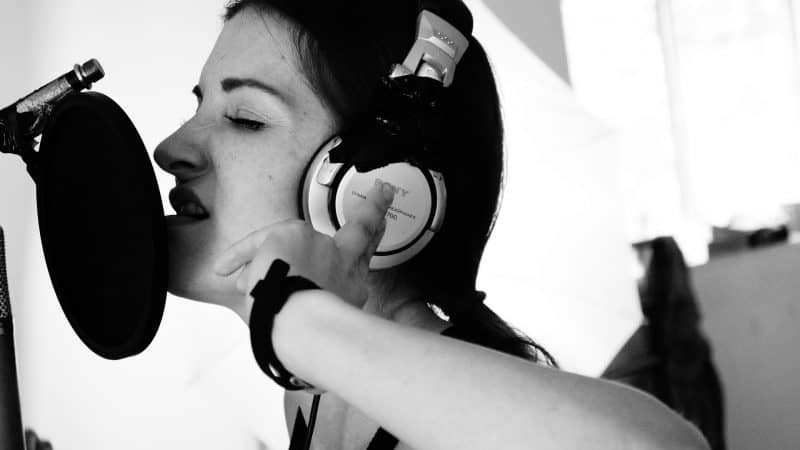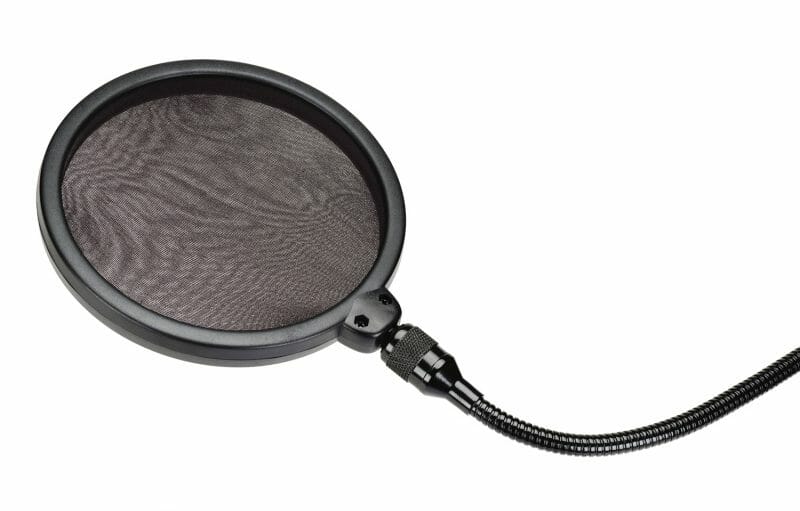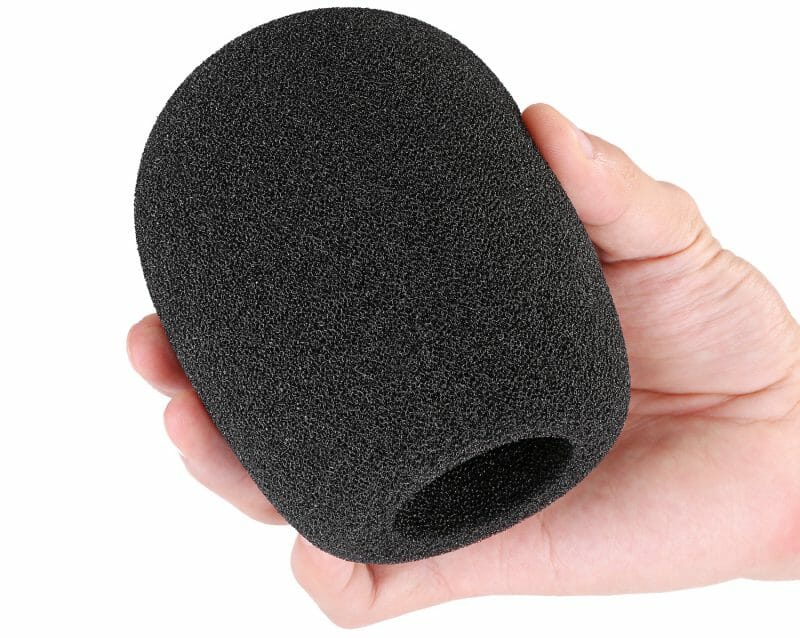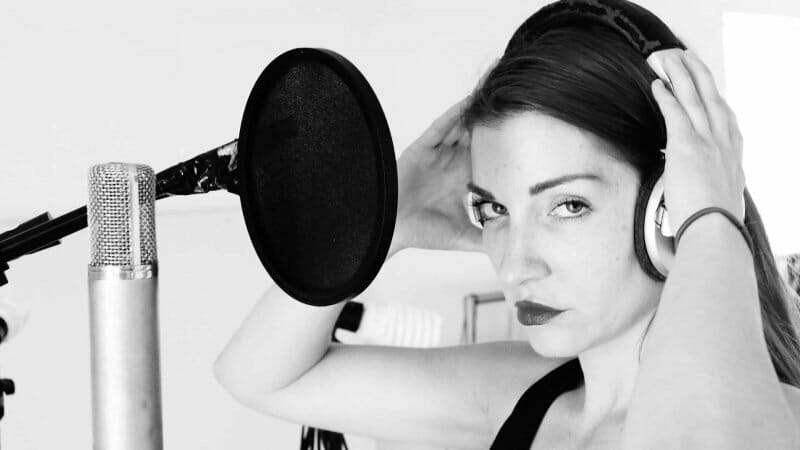Recording vocals at home but keep getting loud, annoying pops in your tracks?
You may need to invest in a pop filter.
A pop filter is essential to recording radio-ready vocals.
In this article, we’ll cover what a pop filter is, why you need one, and the different kinds you can buy.
I’m guessing you’re here because you want to make your mixes sound professional. Well, you don’t need expensive gear or software to do that – you just need the right knowledge. We put together a brief training that covers a totally new approach to music production. Until now, everyone has been teaching production totally backward. Just click below to watch. Get industry-quality every time (steal this framework)
But if you just want to learn about pop filters specifically, keep reading.
What Is a Pop Filter?
Ever seen footage of your favorite artist recording their vocals in a studio?
Most likely, you saw a strange black circle standing in between them and the microphone.

A pop filter is a circle of nylon mesh or thin metal that’s positioned a few inches in front of the mic.
It’s clipped to the mic stand via an adjustable metal gooseneck mount.
Whenever a singer records his or her voice, he or she makes sure to stand a few inches away from the filter.
But why is that? Why do you need a pop filter in the first place?
Why Do You Need a Pop Filter?
Simple – pop filters are used to stop plosives.
Plosives are the blasts of air that come from your mouth whenever you use words with hard letters, like B’s, P’s, T’s, and so on.
Imagine singing a phrase like “break my heart” into the microphone.
It will cause a loud blast of air to head directly towards the microphone’s capsule, causing it to overload unpleasantly. This causes the microphone to “pop” at that point in the word.
A pop filter does exactly what it sounds like: it filters those pops out of your vocal sound.
More specifically, it disperses the air coming from your mouth in different directions.
Then it doesn’t hit the microphone in one big blast. This keeps your plosives from sounding too harsh in the recording.
Plosives sound louder in microphones than they do in the real world. So while you don’t need to carry around a pop filter in your back pocket for every time you sing, a pop filter for recording vocals is necessary.
Plosives are especially harsh in condenser mics. That’s because of the proximity effect.

The proximity effect is where the low end of a voice gets louder and louder the closer the singer gets to the mic.
Since a plosive is mostly low-end energy, this gets amplified even more in condenser mics. That means that using a pop filter with a condenser is basically a necessity.
In contrast, using a pop filter with a dynamic or ribbon mic is very helpful, but not a hard-and-fast rule. However, I’d argue that it’s better to be safe than sorry.
To properly use a pop filter, place it about 2–6 inches away from the microphone. Then place the singer a few inches away from the filter.
If the singer prefers, they can also sing directly into the filter. It doesn’t affect the intensity of the plosives.
Some vocalists prefer this to keep their distance from the microphone consistent.
If you have a singer with extra loud plosives, I’d recommend angling your pop filter 30–45 degrees up or down.
This adds even more wind-dispersal power to the filter. So even less of it reaches the microphone.
Thing of your filter like a mirror. Whichever way you point it, that’s the direction the wind will go.
The Two Types of Pop Filters
There are two types of pop filters available on the market: ones made of nylon mesh or thin metal.
The nylon mesh pop filters are the original version of the tool. They’ve been used for decades.

On average, these run around $20 on average, depending on the brand you buy.
Mesh pop filters are a fine option. They’ll do a good job of accomplishing their main job – stopping plosives.
However, some engineers claim that mesh pop filters can actually cut some of the top end off a vocal. To combat this, metal pop filters made their way onto the market.
Metal pop filters are a more recent invention, only being around a few decades.

They’re typically a tougher build, so they’ll last longer than their mesh counterparts.
They also can be easily washed. You can get rid of all the spit that’s probably built up on your filter over dozens of uses.
Most importantly, they claim to keep the top end of the vocal completely intact.
This hasn’t been formally proven to be a real issue with the mesh version. However, vocals do tend to sound a little more accurate with a metal filter.
On average, a metal filter will run around $50, depending on the brand you buy.
So which should you buy? To be honest, whichever is in your budget.
The metal filter will last you longer, and you won’t risk breaking it while washing it. But the mesh filter is cheap, dependable, and easily replaceable.
If you feel the need to splurge for a nicer build, go for a metal filter. If not, a mesh filter will work just fine.
What About a Windscreen?
A lot of people ask if windscreens can be used as an alternative to pop filters.
In a word… no.

A windscreen is a large foam cylinder that’s put on the end of microphones when recording outside.
They’re made specifically to deflect wind when being used outside at concerts, interviews, or film shoots.
They’re not made to hold up against the concentrated wind of a plosive. Because the singer is so close to the mic, the windscreen just doesn’t do much to stop the plosive.
They do, however, cut a lot of the top end out of the sound of the microphone. So they don’t help with plosives, and they make your vocal sound worse.
Unless you are using them for what they are designed for, avoid using a windscreen.
Conclusion
The most important lesson to take away from this… preparation is important.
Want to have professional sounding vocals? You have to put in the time and effort to make sure they sound as good as possible before you hit the record button.
If you want to dig deeper into music production and learn what it actually takes to make mixes that sound pro… And you’re an intermediate or advanced producer… Be sure to check out the free masterclass: Enjoy!Next Steps










